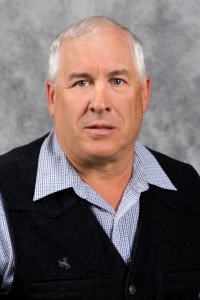
Eminent Farmer/Rancher
County: Codington
In his father’s day, the harder you worked, the better off you were. John Moes learned quickly that this mantra did not ring true for him.
“In the late ‘70s those of us getting our start farming realized that you had to work smarter, not necessarily harder, to make it,” explains the Codington County cattle and crop producer and 2017 Eminent Farmer/Rancher.
A self-described “micro-manager,” Moes keeps meticulous production records on his Angus herd; beyond the basics, he documents the number of illnesses, ability to achieve and maintain pregnancy and carcass data from their offspring. In the feedlot, Moes tracks every head with an electronic identification (EID) tag and pays for carcass data.
“If we work by the details then we can see what is working and profitable and what is not,” he says.
Moes implements an intensive synchronization program where he AIs (artificially inseminates) his entire herd of cows and heifers within 48 hours – resulting in a 10-day calving season.
“Uniformity pays,” Moes says. “We have this technology available to us that allows us to do this. When it comes to technology I say, ‘use it or lose it.’”
He explains, “If they are all born within 10 days instead of 21 days, you have 20 days of gain – that’s about 40 pounds per calf – that adds up quickly. Sixty animals - that’s 2,400 more pounds to sell.”
To keep up with new research and technology, Moes is always educating himself. An avid reader, he consumes industry magazines and attends workshops put on by South Dakota State University and others. In 2003, he volunteered to participate in a synchronization study led by George Perry, Professor and SDSU Extension Beef Reproductive Management Specialist.
“It’s not what I know, it’s what I learn,” Moes explains.
His willingness to learn and try new things has served him well. Today, Moes, 60, together with his son, Bryan, and nephew, Lee Tol, operate a 300-head cow/calf herd; a 1999-head Concentrated Animal Operation, which primarily feeds and finishes Holstein steer calves; and farm 1,000-acres of grain and forage crops near Watertown.
However, when he started out, he only had a twelfth-grade education and work experience from growing up on his family’s dairy farm.
Moes slowly began building his cow/calf herd while working for an area farmer. When he and his wife, Donita, purchased a small farm in 1987, he began working in town full-time until the cattle herd expanded to the point it needed his full-time attention. He says land prices kept him focused on expanding his cattle operation and the local ethanol industry helped with feed supplies.
“We feed 50-ton of modified distillers grain each week. It’s a consistent feed and protein source,” he says.
Looking at his operation today, it’s obvious that Moes practices what he learns. And, he’s not afraid to share his knowledge.
Each year, the farm hosts tours for SDSU and Lake Area Technical Institute students, as well as producers from across the nation and world. Moes continues to participate in research projects. And, each year, he employs at least one intern.
His advocacy for the beef industry extends outside the industry as well. Throughout the year he invites grade-school children and area business owners to learn about life on the farm.
“We open our farm up because people today are so removed from what we do here,” he says.
Much of his public education focuses on the investment he makes to raise healthy and comfortable animals while improving natural resources at the same time.
“To do this and do it well, you gotta have passion for cattle. And I do.”

